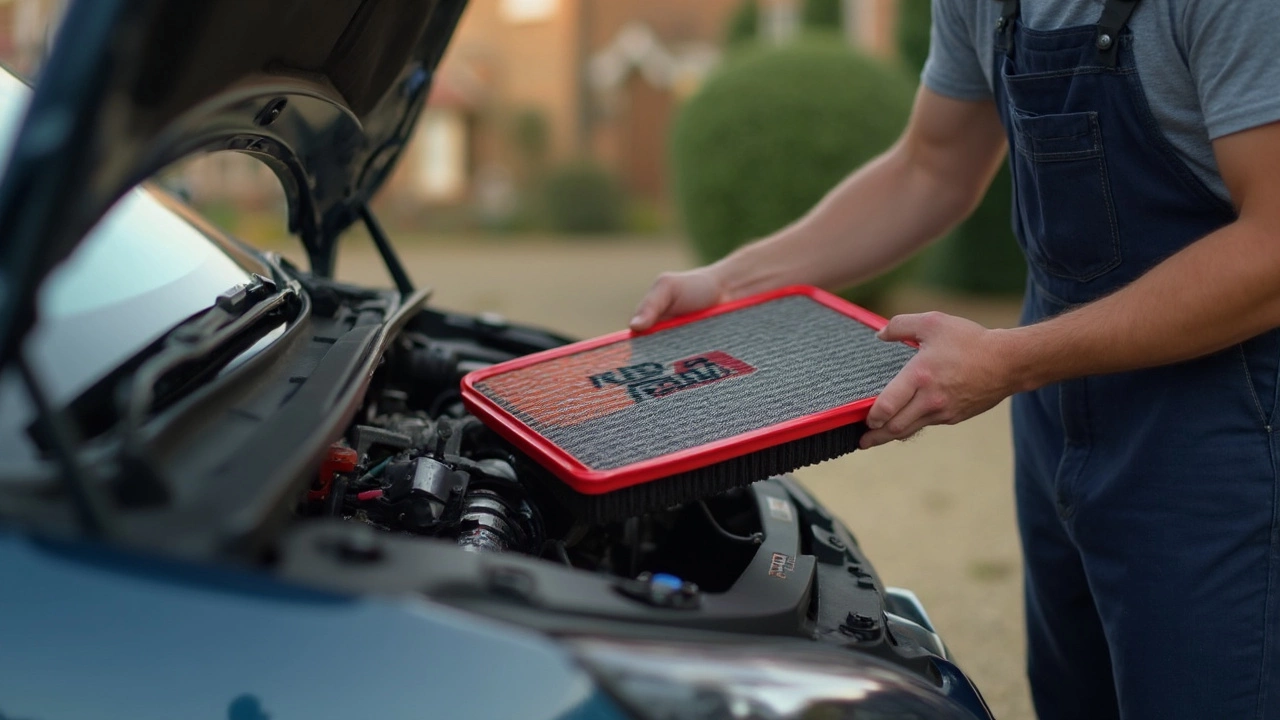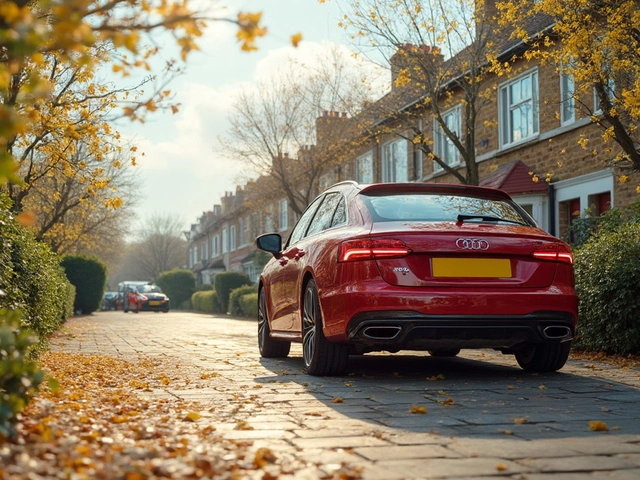Pop the hood at any car meet, and chances are you’ll spot at least one K&N air filter. They’re everywhere, and folks swear by them for getting a little extra kick from their engines. But are they actually worth swapping out your old filter? The answer isn’t as clear-cut as K&N ads make it sound.
Here’s the deal: K&N filters are designed to let your engine breathe easier. Instead of trapping every speck of dust like a paper filter, they use layers of cotton soaked in oil to catch the big stuff while allowing more air to pass through. More air can mean better performance—or at least, that’s the promise.
However, there are trade-offs. Not everyone sees a huge bump in horsepower, and the way you take care of these filters can become a bit of a chore. Plus, if you’re someone who racks up miles on dusty backroads, you might want to think twice before switching.
Let’s dig into the real pros and cons, plus a few tips from drivers who've tried K&N filters on their daily rides and track toys. By the end, you’ll know if this upgrade should be on your to-do list or if you’re better off sticking with what you’ve got.
- What Sets K&N Air Filters Apart?
- Performance Gains: Real or Hype?
- Cost and Longevity—Are They Worth It?
- Maintenance: Simple or a Hassle?
- Warranty and Engine Safety
- Who Should Use K&N Air Filters?
What Sets K&N Air Filters Apart?
You see K&N air filters all over car forums and YouTube builds for one simple reason: they do things differently than your regular paper filter. First off, they’re reusable. Instead of throwing it away every time your service light pops on, you clean it, oil it, and put it right back in. They claim these filters can last for the lifetime of your vehicle if you take care of them right.
What gives K&N their reputation is the design. They use multiple layers of oiled cotton gauze, sandwiched between wire mesh, instead of a plain old disposable paper filter. This setup claims to boost airflow to your engine. With more air coming in, your engine doesn’t have to work as hard to suck it in, which, in theory, means better throttle response and maybe a little bump in horsepower.
Here’s something real: K&N says their filters can improve airflow by up to 50% compared to standard paper filters. The table below breaks down some key differences drivers notice:
| Feature | K&N Air Filter | Paper Air Filter |
|---|---|---|
| Type | Oiled cotton gauze (reusable) | Pleated paper (disposable) |
| Airflow | High (up to 50% more) | Standard |
| Lifespan | Up to a million miles (with cleaning) | 15,000–30,000 miles |
| Maintenance | Wash and re-oil every 50,000 miles (varies) | Replace when dirty |
Maybe the biggest reason people buy them: once you shell out for a K&N air filter, you’re mostly set. No more grabbing a new filter every couple oil changes. For drivers racking up miles or anyone handy with a wrench, it feels like one less thing to worry about. But, as you’ll read later, there are some catches, so don’t toss your stock filter just yet.
Performance Gains: Real or Hype?
When you hear someone talking about K&N air filters, performance is usually the first thing that pops up. They’re marketed as a simple way to boost horsepower and create a meaner engine sound. But does slapping one of these filters on your car actually make a difference?
The honest answer: it depends on your car and your expectations. A bunch of dyno tests and user reports say you might see a bump in horsepower. We're usually talking 1 to 4 horsepower on most stock engines, and usually only at higher RPMs. For everyday driving, that difference is pretty hard to notice. If your car already has a high-performance intake system, the gain gets even smaller because the stock system isn’t really choking your engine in the first place.
Where performance air filters like K&N’s shine is in airflow. A paper filter can get clogged up quicker, while a K&N breathes easier—especially as it gets dirty. You might notice a crisper throttle response or hear your engine growl more on hard acceleration. But if you’re expecting a night-and-day transformation just from an air filter, you’re going to be disappointed.
People who notice the biggest changes are drivers who combine a K&N air filter with other upgrades, like a cold air intake or custom exhaust. In those kinds of setups, letting more air in and out of the engine actually means something. Here’s a quick look at what real-world numbers can look like:
| Test Vehicle | Stock HP | K&N HP | Difference |
|---|---|---|---|
| Honda Civic 1.8L | 140 | 142 | +2 HP |
| Ford Mustang GT 5.0L | 435 | 438 | +3 HP |
| Toyota Camry 2.5L | 178 | 179 | +1 HP |
One thing a K&N filter will almost always do, though: make your engine sound a little throatier under heavy load. That’s a nice bonus if you want a bit more character from your daily driver or weekend toy.
Bottom line? K&N air filters offer some real gains, but they’re not magic. If your engine is stock and you’re just looking for a cheap horsepower fix, you might want to curb your expectations. If you’re already modding your ride and you want all the air your engine can get, a K&N is a solid step in the process.
Cost and Longevity—Are They Worth It?
Let’s talk dollars and sense with K&N air filters. One thing’s for sure: you’ll pay more upfront, usually between $50 and $80 depending on your ride. That’s a hit compared to the $10 you’d drop on a regular paper filter at your local parts store.
So, do you really get your money’s worth? K&N shouts about their million-mile warranty—and that’s not an exaggeration. If you clean and oil the filter as they recommend (usually every 50,000 miles for regular driving), it’s meant to last as long as your car does. No more tossing dirty filters in the trash every oil change.
- Reusable design: You can wash and reuse a K&N filter, so you’re not buying new ones every year.
- Long-term savings: If you hang onto your car for a few years or rack up big miles, you’ll start to notice the savings pile up—though it takes a while to break even if you drive less.
- Maintenance kit needed: You’ll need K&N’s special cleaning and oiling kit, which costs around $15–$20 and lasts a few cleanings.
Check out this quick breakdown of typical costs over five years for comparison:
| Filter Type | Upfront Cost | Replacement Filter/Kit(s) | Total 5-Year Cost* |
|---|---|---|---|
| Paper | $10 | 4 x $10 | $50 |
| K&N | $60 | 1 Cleaning Kit | $75–$80 |
*Assuming replacement/cleaning every 12 months
You’re paying a bit more for convenience and less landfill waste, but if you trade vehicles frequently or hate a little extra maintenance, traditional filters might still suit you. If you’re planning on keeping your car for the long haul, or if you’re tired of buying new filters all the time, a K&N air filter can make sense financially and practically.

Maintenance: Simple or a Hassle?
Let’s talk about what actually happens after you drop a K&N air filter under the hood. These filters are reusable, which sounds great—no more buying paper replacements every oil change. But the catch? You’ve got to clean and oil them about every 50,000 miles under normal driving, or even sooner if you’re running through dust and dirt a lot.
K&N says the cleaning process is easy, but not everyone agrees. You’ll need a cleaning kit with a special spray and filter oil. The steps go like this:
- Remove the air filter from your car.
- Spray on K&N’s cleaner (don’t use random chemicals—those can mess things up).
- Let it soak for 10 minutes, then rinse with cool, low-pressure water.
- Let the filter air dry (this can take a couple hours).
- Apply K&N filter oil evenly. Don’t overdo it—gummy filters mess with your sensors.
- Pop it back in and you’re set.
This isn’t rocket science, but it’s not as quick as tossing a paper filter, either. Forgetting to dry it out fully or using too much oil can cause problems. Too much oil, for example, may lead to “oiled filter syndrome,” where the excess clogs up mass airflow sensors. That’s a common gripe from mechanics.
Car and Driver put it bluntly in a 2022 review:
“While reusable K&N filters save money in the long run, the cleaning and oiling process takes time and has to be done right to avoid headaches.”
If you like doing your own car work and don’t mind a little mess, you’ll probably get along fine. But if changing out filters is already a stretch, sticking with basic paper filters might save you some hassle in the long run.
Here’s one thing to keep in mind: routine cleaning and oiling keeps performance up and your warranty intact. Skipping maintenance will clog that high-flow filter and take away any benefits fast.
Warranty and Engine Safety
This is where things start to get real for a lot of people thinking about K&N air filters. Some car owners worry that swapping out their regular filter for a performance one might mess with their engine warranty. Here’s the truth: just having a K&N air filter isn’t supposed to void your warranty. The Magnuson-Moss Warranty Act says a dealer can’t deny you coverage just for using aftermarket parts, unless they can prove that part caused the damage.
But it’s not always that simple in practice. There have been cases where dealerships blamed a dirty or oiled K&N air filter for problems like mass airflow sensor issues or engine trouble. If the filter is over-oiled or not installed correctly, it can lead to oil getting on your sensors, which triggers warning lights and rough running. That’s not super common, but it’s happened enough for people to share their stories online.
- If you plan to do your own maintenance, follow K&N’s instructions to the letter. Don’t over-oil the filter after cleaning—just a light mist is enough.
- If a dealer tries to blame the filter for something, ask for proof that the filter is really the cause. The law’s on your side unless they have real evidence.
- Keep your original paper filter handy, just in case you need to swap it back before any big service visits. It’s a small hassle but can save some drama.
K&N stands by its filters with a "Million Mile Limited Warranty". As long as the filter’s cared for right, they’ll replace it if there’s a manufacturing issue. Just remember, that warranty covers the filter itself—not your engine. If an engine part fails, you’ll still have to show it wasn’t because of the filter.
| Potential Issue | Covered by K&N Filter Warranty? | Covered by Vehicle Warranty? |
|---|---|---|
| Filter Defect | Yes | No |
| Engine Damage from Poor Filter Maintenance | No | No |
| Engine Damage Unrelated to Filter | No | Yes |
Bottom line: K&N air filters are pretty safe if you follow the directions and don’t go nuts with the oil. Most problems come down to bad installs or using the wrong cleaning kit. If you’re careful, you shouldn’t have trouble with your maintenance or warranty.
Who Should Use K&N Air Filters?
If you’re just driving to the grocery store and back every week and never pop the hood, swapping to a K&N air filter probably won’t change your life much. But there are a few folks who’ll benefit a whole lot more from making the switch.
- Car enthusiasts and tuners: If you’ve tweaked your engine, adjusted your exhaust, or just enjoy squeezing every ounce of power from your vehicle, a K&N air filter can round out your upgrades. It’s a popular entry-level mod for folks who like fine-tuning how their ride feels and sounds.
- Drivers logging big highway miles: The reusable nature of these filters means less frequent replacements. Road trippers and sales folks covering hundreds of miles each week won’t have to buy new filters as often—just clean and re-oil when it’s needed.
- Off-roaders (with caution): Some Jeep or truck owners prefer K&N air filters for their airflow on dirt trails. But—and it’s a big but—you’ll need to clean and maintain your filter religiously if you spend time in dusty areas, since oiled filters can clog up faster than paper ones if neglected.
- People looking to save long-term: The up-front cost is higher, but since K&N air filters are reusable, you’ll save on buying new paper filters every 15,000 miles or so. If you keep your vehicle for years, those savings add up.
There are some folks who should probably skip it, though. If you drive somewhere super dusty all the time, don’t want to mess with cleaning and re-oiling, or have a car that spends more time idling than accelerating, the benefits just aren’t as noticeable. Also, if you have a newer car and want to keep your factory warranty rock-solid, stick with the stock filter or check your owner’s manual for what's approved.
Check out this quick breakdown of who usually gets the most out of a K&N air filter:
| Type of Driver | Should Use K&N? | Why / Why Not |
|---|---|---|
| Performance Enthusiast | Yes | Wants more airflow, tweaks other mods |
| Average Commuter | Maybe | Saves money long term, but less noticeable performance |
| Off-Roader | Maybe | Great airflow, but needs frequent cleaning |
| High-Mileage Driver | Yes | Reusable filter saves on replacements |
| Warranty Worrier | No | Some automakers challenge warranty claims with oiled filters |
| Low-Maintenance Driver | No | Cleaning and oiling takes work |
So, if you’re ready for some light maintenance and want a little more from your engine, K&N air filters could be a smart pick. Just make sure it fits how you use your ride and how much time you want to spend under the hood.






